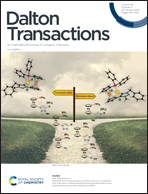Effect of anion dimensionality on optical properties: the ∞[B7O10(OH)2] layer in CsB7O10(OH)2vs. the ∞[B7O12] framework in CsBaB7O12†
Abstract
Two new caesium borates, CsB7O10(OH)2 and CsBaB7O12, were synthesized in a high-temperature vacuum system and high-temperature open system, respectively. They all crystallize in the monoclinic space groups, C2/c (no. 15) and P21/c (no. 14), respectively. Their structures show different dimensional anionic architectures. CsB7O10(OH)2 has two-dimensional (2D) ∞[B7O10(OH)2] anionic layers with the [B7O12(OH)2] fundamental building block (FBB) which displays a novel connection mode. CsBaB7O12 possesses a three-dimensional (3D) ∞[B7O12] anionic open-framework with the [B7O15] FBB. The characterization of their properties combined with experimental and theoretical methods reveals that the two hepta-borates show differences in their optical properties due to their different optical anisotropies which are influenced by their anionic structures. The former compound CsB7O10(OH)2 presents a wide band gap of 6.6 eV and the latter compound CsBaB7O12 presents a band gap of 5.6 eV, which is smaller than that of CsB7O10(OH)2. The first-principles calculation results suggest that the birefringences are 0.08 and 0.05 at 1064 nm for CsB7O10(OH)2 and CsBaB7O12, respectively. Furthermore, the detailed summaries and structural comparisons have been provided for all available disorder-free mixed alkali- and alkaline-earth metal caesium borates.
![Graphical abstract: Effect of anion dimensionality on optical properties: the ∞[B7O10(OH)2] layer in CsB7O10(OH)2vs. the ∞[B7O12] framework in CsBaB7O12](/en/Image/Get?imageInfo.ImageType=GA&imageInfo.ImageIdentifier.ManuscriptID=C9DT04539B&imageInfo.ImageIdentifier.Year=2020)


 Please wait while we load your content...
Please wait while we load your content...